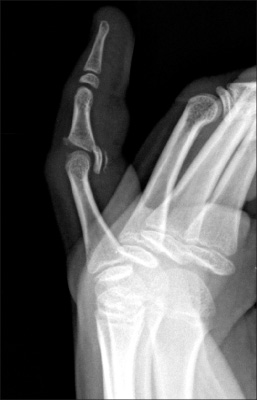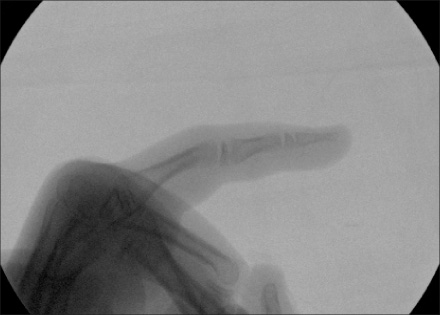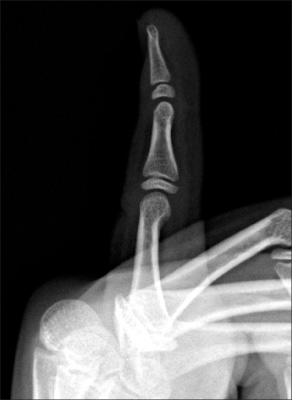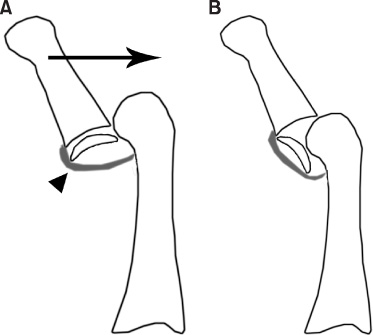J Korean Orthop Assoc.
2008 Apr;43(2):262-265. 10.4055/jkoa.2008.43.2.262.
Volarly Displaced Epiphyseal Fracture of the Middle Phalanx: A Case Report
- Affiliations
-
- 1Department of Orthopedic Surgery, School of Medicine, Ewha Womans University, Seoul, Korea. kimjk@ewha.ac.kr
- KMID: 2106450
- DOI: http://doi.org/10.4055/jkoa.2008.43.2.262
Abstract
- A 12-year old boy sustained a volarly displaced fracture of the middle phalanx after sustaining a hyperextension injury to the fifth finger. The alignment of the proximal interphalangeal (PIP) joint was maintained and the articular surface of the displaced epiphysis faced the proximal phalangeal head. This is different from case reported elsewhere, which described volarly displaced epiphyseal fractures during the reduction of a volar PIP dislocation. This means that the pathomechanism in the present case is different from the previously reported cases. The closed reduction was successful and the hand function of the patient was satisfactory at the 6 month follow-up.
Figure
Reference
-
1. Baugher WH, McCue FC 3rd. Anterior fracture-dislocation of the proximal interphalangeal joint. A case report. J Bone Joint Surg Am. 1979. 61:779–778.
Article2. Hashizume H, Nishida K, Mizumoto D, Takagoshi H, Inoue I. Dorsally displaced epiphyseal fracture of the phalangeal base. J Hand Surg Br. 1996. 21:136–138.
Article3. Jones NF, Jupiter JB. Irreducible dislocation of the proximal interphalangeal joint associated with an epiphyseal fracture of the middle phalanx. J Hand Surg Am. 1985. 10:261–264.4. Keene JS, Engber WD, Stromberg WB Jr. An irreducible phalangeal epiphyseal fracture-dislocation. A case report. Clin Orthop Relat Res. 1984. 186:212–215.
- Full Text Links
- Actions
-
Cited
- CITED
-
- Close
- Share
- Similar articles
-
- Fracture of Distal Epiphysis of Femur during Childbirth: 10-Year Follow-Up Report
- Conservative Treatment of Moderately Displaced S-H type II Injury in Distal Radius : a Report of 5 Cases
- A Clinical Observation for the Fracture of Proximal Phalanx of the Great Toe(So Called Safety shoes-Fracture)
- Fracture of the First Sacral Vertebral Ring Epiphysis Simulating Disc Rupture: A Case Report
- Displaced fracture of the base of the second metacarpal into velar side







